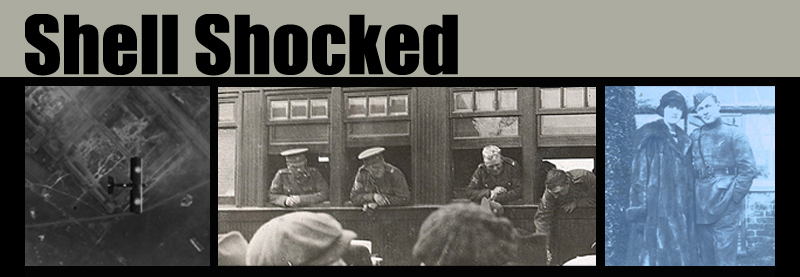More for the Mind: Home > Shell Shocked Home > Shell Shocked: Lesson 1
Lesson One: ‘Shell Shock’
Approximately one hour
 Opener: (10-15 minutes)
Opener: (10-15 minutes)
- Briefly review or introduce trench warfare as experienced in WWI
- Ask students to imagine being a soldier in a trench and explain that many soldiers experienced ‘battle fatigue’ or ‘shell shock’ because of the stress
- Show “Shell Shock and the case of Henry Farr” (WARNING: some profanity) Originally from a documentary called “Not Forgotten,” the video uses footage from the time period and interviews with family members
- Alternate video: “WW1 Shellshock.”
 Discussion: (10-15 minutes)
Discussion: (10-15 minutes)
- Discuss the video asking students to give plausible answers to the following: What caused ‘shell shock’? How was it treated? What problems would a soldier with ‘shell shock’ face? Why would a soldier suffering with ‘shell shock’ be executed rather than treated? What would we call ‘shell shock’ today (post-traumatic stress disorder PTSD)?
- For more information about PTSD, see the resources for the extension activity
 Activity One: Investigating Shell Shock (20-30 minutes)
Activity One: Investigating Shell Shock (20-30 minutes)
- Have students investigate ‘shell shock’ using internet sources
- Ask students to categorize their findings
- The symptoms and cause of shell shock (focus for today’s lesson)
- Treatment
- Background information about the time period- life at war
 Closing: (10 minutes)
Closing: (10 minutes)
- Take a few student comments about their research to and use them to summarize what shell shock was, how it was treated and what the time period was like
- Ask them what they found surprising
- Ask for opinions about how the soldiers were treated and possible explanations why
 Reaching All Learners
Reaching All Learners
- Students could work in pairs in the computer lab to help each other with reading, comprehension and to talk about the significance of the material
- Some students may benefit from having a specific article to investigate and a guideline for notes, for example, a fill-in-the-blanks sheet or headings for note taking
- Some classes may benefit from a group review of the resources, especially the photographs and sketches. This allows the teacher to guide the learning, and teach students how to infer from visual information
- Some students may not be familiar with using photographs or sketches to obtain information. Look at several sketches or photographs as a class and practice inferring information from them. A good way to do this is to make a table like the one below. First, fill in the right hand column with facts. For example, there are two men wearing heavy coats with scarves. Then ask the class to make inferences. For example, it’s cold out; maybe it’s winter. List as many facts and inferences as the students can find. When you are done, review all the inferences and find the ones that make sense together
| What I see | What I infer | |
| Who? | 2 men with grim faces | Men are sad, don’t want to be doing what they are doing |
| What? | Walking in heavy coats& scarves
Truck with a red cross in the background Smoking ruin in the background |
Cold out
Men are with the Red Cross Just after a battle |
| Where? | On a dirt road | In the country |
| When? | No leaves on the trees
Old fashioned clothes Dirt road Black and white photo Day |
Fall or winter, day, a long time ago |
| My guess | The men are looking for wounded soldiers after a battle | |
 Resources for ‘Shell Shock’ lesson:
Resources for ‘Shell Shock’ lesson:
- YouTube video “Shell Shock and the case of Henry Farr”
- YouTube video “WW1 Shellshock”
Activity
- BBC article on ‘Shell Shock’
- Encyclopedia entry on ‘Shell Shock’
- Sketch: “The Grim Reaper” 1917
- Sketch: “Canadians fighting at Ypres” 1917
- “Sketch of Red Cross Corps searching for wounded at night” 1917
- Sketch: “British Troops Charging” 1918
- Sketch: “Watching Gunfire” 1918.
- Photo: “Shellshock2” 1917
- Poem: “Repression of War Experience” 1918
Extension
